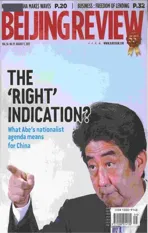More Investment Potential
2013-12-06ByMeixinyu
By Mei xinyu
It’s time for China to amend its investment treaties with other countries, especially the United States

The author is a researcher with the Chinese Academy of International Trade and Economic Cooperation
At the recently concluded fifth meeting of the China-U.S. Strategic and Economic Dialogue (S&ED), it was noted in one report that, “China and the United States recognize that a bilateral investment treaty (BIT)that sets high standards, including openness,non-discrimination and transparency, would be important to both sides, and welcome the progress made in the BIT negotiations to date. The two sides reaf firm their shared commitment to enhance openness, accord fair and equitable treatment, and contribute to the reduction or elimination of discriminatory practices and market barriers. After nine rounds of technical discussions, China is to enter into substantive BIT negotiations with the United States.”
These words, one of the more enticing from the meeting, mark a new round of BIT talks between the two countries, which began in 2008.
An urgent need
Bilateral treaties can better meet the demands of countries concerned than an international law. Since a consensus on an international investment law has not yet been reached among international organizations, BIT is still playing an indispensable role in the protection of international investment. For this reason, BIT has been the first choice for capital exporting countries,including Britain and the United States as well as emerging investors like China, to protect their outward direct investment. Capital-rich and hi-tech investors tend to ensure that they are under the wing of BITs before making investment decisions. When the reform and openingup policy was first put into practice, nearly 20 Western countries signed BITs with China.Foreign direct investment then began to flood into the world’s largest developing country.
As a rising power of outward direct investment, Chinese investors as well as the Chinese Government are calling for amendments to BITs to improve the system for protecting their investments abroad.However, China is lagging far behind on this front. It signed the Encouraging Investment Agreement and Exchange of Note on Investment Insurance and Guarantee Between the People’s Republic of China and the United States of America as early as October 30, 1980, and then reached similar bilateral agreements with more than 100 countries. Yet, most of these treaties are congenitally deficient. Moreover, China’s rapid social and economic development has outpaced the improvement of these agreements.
Counting in polite formula, the Agreement and Exchange of Note includes only eight terms, nothing but making sure that the investment insurance and guarantee system of private American overseas investment companies can be applied to American companies’ investments in China.Obviously, the agreement cannot effectively regulate and protect mutual investment between the two countries any more.
For Chinese companies, the United States has become an investment destination with the most political risks among developed countries. Since China began to directly invest in the United States in the early 1990s, Chinese companies have been dispirited again and again in their attempts to invest in the United States. As a result,there is a gap between China’s direct investment in the United States and America’s direct investment in China.

DOING BUSINESS IN CHINA: Workers toil away at an Amazon warehouse in Kunshan,east China’s Jiangsu Province, on January 16, 2012
According to the 2011 Statistical Bulletin of China’s Outward Foreign Direct Investment, China’s total direct investment in the United States at the end of 2011 was a mere $8.99 billion. Speci fically, direct investment in the United States amounted to $1.81 billion in 2011 and $2.62 billion in 2012.
While politics has been a factor, the absence of a new China-U.S. investment treaty should also be blamed for the low numbers.
The China-U.S. BIT talk will not just affect investments between the two countries. For one thing, China has been the most popular investment destination among developing countries for over two decades, and now it’s also the most eye-catching emerging exporter of direct investment; for another, the United States has been both the top exporter and destination of direct investment for decades.
Considering that China is in urgent need to sign and amend BITs with almost all major trade partners, and the United States has been the most in fluential country in molding international economic and trade rules since World War II, the China-U.S. BIT could be an example for similar agreements between China and its other trade partners.
U.S. action is key
The success of the China-U.S. BIT talk is dependent on both sides, but more so the United States. By now, the Agreement and Exchange of Note is the only bilateral treaty on mutual direct investment between China and the United States, which doesn’t utter a single word about China’s investment in the United States.
Since China opened to investment years ago, it has been widely considered a successful example for many countries and regions looking to attract foreign investment. It even gives super-national treatment to foreign investors. With a strong will to constantly improve its investment environment, China welcomes investors from all the corners of the globe to pursue entrepreneurship on its land. The United States has benefited a lot from China’s “probusiness” policies and measures.
In the fifth round of the China-U.S. S&ED, China reaffirmed its promise to implement a more active opening up strategy. Now, China is trying to figure out measures to further open up its services industry to the outside world, including setting up a Shanghai pilot free trade zone. In addition, China is motivated to create more efficiency in its economy.It will do its utmost to reduce bureaucracy and give more freedom to enterprises and individuals, making it easier to attract investment.
The United States has grown by absorbing talent and investments from across the world,and hitherto, it has the most propitious business environment for foreign investors. In the United States, legitimate companies are free from concerns over social unrest and blackmail from government officials, which often happen in developing countries. However,it takes a cautious approach in admitting foreign investments from countries that may pose a political threat. Now, many in America see China as a competitive rival, which has turned the United States into an investment destination with the most political risks for Chinese investors.
In 1990, the Bush administration cited the Exon-Florio Amendment to block the acquisition by China National Aero-Technology Import and Export Corp. of MAMCO Manufacturing, Inc. In 2005, China National Offshore Oil Corp. failed to acquire Unocal Corp. In 2011, Huawei Technologies Co. Ltd. was forced to return part of the assets it acquired from 3Leaf Systems, a server technology company.
Countless acquisitions have been denied by the United States to ensure so-called“national security,” which has hurt Chinese companies hard. Some American politicians even try to hinder China’s investment in other countries. When Hong Kong-listed Hutchison Whampoa obtained the management rights of two ports in the Panama Canal Zone, some American senators attacked it as an attempt to expand China’s military presence in the backyard of the United States.
Furthermore, China National Petroleum Corp. and China Petrochemical Corp. were prohibited from exploring for oil in a number of other countries and regions because of U.S.interference. When China’s sovereign wealth funds tried to step into credit financing and equity investment, some forces in the United States took it as a sign of a “China threat” rather than as a new channel to introduce Chinese investment into the country.
After the sub-prime crisis, the U.S.Government showed great enthusiasm in attracting foreign investments to promote employment, and the “Choose America”plan pushed by President Barack Obama aimed to expand investments from emerging countries like China. However, China is hardly motivated to directly invest in the United States. In this sense, it serves both sides to promote BIT talks to enhance openness and transparency, especially on the side of the United States.
Only by taking concrete steps can the United States create a more fair investment environment and bring more opportunities for both Chinese and American enterprises. ■
